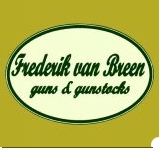CHECKERING
Checkering are rows of parallel grooves that cross at a given angle to form little diamond shapes. In the English literature, checkering is often spelled 'chequering'.
The function of checkering is to give the shooter more grip on the stock especially when wet or greasy. To wick perspiration away from the hands during shooting and as decoration. Checkering is not really neccessary on most stocks, so the decorative aspect is probably the most important.
Checkering in its current form started to occur about 150 years ago. Checkering was not a new thing of course but patterns and ways of application were usually different.
The checkering can be cut in several ways. Most commonly applied techniques are pointed, flattop and semi flattop checkering. Another variety is skip line or French checkering. In this technique lines are simply skipped at regular interval creating a tartan like effect hence it is also called Scottish checkering.
1 Pointed checkering.
The grooves are cut under a 90 degree angle (sometimes 60 degree). This is the most common type of checkering.
The checkering consists of sharply pointed diamonds that give a good grip and the grooves are self cleaning due to their open angle of 90 degrees.
The checkering can be a bit to sharp especially after long shooting sessions or on heavy recoiling guns.
On the checkered area the surface will be broken so that the figure of the wood may be not so visible depending upon the quality and coarseness of the checkering job and of course the wood itself.
| 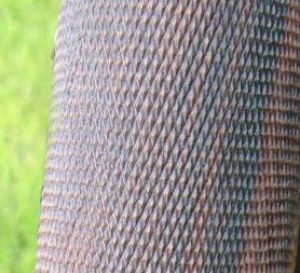
|

| 2 English flattop checkering.
The grooves are cut under a zero degree angle. Just deep shallow grooves with parallel walls cut into the wood. This type of checkering is often seen on older English guns. Currently loosing popularity.
Disadvantage is that the grooves easily fill up with debris making it useless. The checkering is not sharp so it does not offer as much grip.
Because of the flat tops the figure of the wood is less obstructed by it.
Advantage, the checkering is not sharp so it is more comfortable on heavy recoiling guns or on prolonged shooting sessions.
English flattop checkering can be converted into pointed checkering by recutting the grooves with an angled cutter.
|
3. Semi flattop checkering.
The grooves are cut under 60 degree angle (sometimes 90 degree). However the grooves are shallow so that there are no pointed tops to the diamonds. Semi flattop checkering is often done to imitate English flattop checkering. The grooves are a little less prone to clogging up with debris as in the English checkering and the diamonds are not as sharp as those of the pointed checkering.
The pattern is of the fill in type as can be seen by the border line that does not run parallel with the checkering.
| 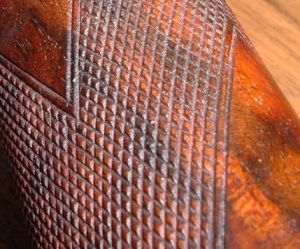
|
Checkering patterns
Checkered lines together form a pattern. Several patterns are possible. Usually the edges of the checkering are defined by borders. Sometimes no borders as such are present. The checkering simply stops and the borders are formed by the lines themselves or a very this line is cut. This is called borderless checkering.
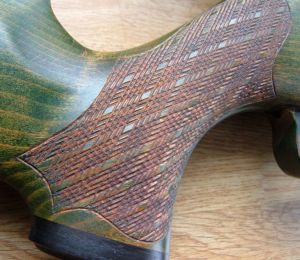
| Fill in pattern
The border (outline) of a panel is cut into the wood. The space within the panel is filled up with checkering. Some fill in patterns may look a lot like angular patterns but the difference can be seen because on one of the sides of the design the border does not run parallel with the checkering.
Shown on the left is a fill in pattern executed with skip line checkering also known as French checkering of Scottish checkering for the resemblance to the scottish tartan pattern.
|
Fancy checkering
Americans are absolute masters when it comes to checkering some of the most intriguing and difficult patterns. Occasionally, fancy checkering is seen on expensive European guns.
On the right is a picture of a exceptionally beautiful Parker shotgun. Made in the days when labour was relatively cheap and people still had the patience to spend countless hours on the perfect execution of very complex checkering patterns.
European approach to checkering was a lot more practical. With simple, angular patterns being the norm on even the most expensive guns. Under influence of American examples, Europeans have started to put more emphasis on the design and execution of the checkering panels.
| 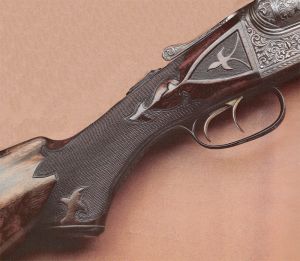
|
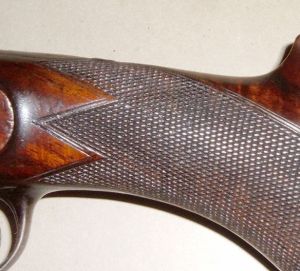
| Angular pattern
This is a challenging way of checkering since the border lines are formed by the checkering itself and should run perfectly parallel to the grooves. A lot of care must be taken to make sure that the angles are respected. If the angles are cut right, regular diamonds are formed with their tips nicely aligned, defining the outline of the pattern.
This type of checkering is usually seen on the better grade of stocks. Normally all best guns stocks have angular pattern checkering.
The example on the left shows an antique British single shot rifle with typical flattop checkering the borders run exactly parallel with the lines of the checkering making it an angular pattern.
Over the last century, the lines of the checkering have been partially filled up with debris.
|
Wrap around pattern
These patterns can either be of the fill in or angular type. Wrap around simply means that the checkering extends from one side of the stock to the other.
The photo on the right shows a wrap around, angular pattern. The checkering is pointed checkering at 20 lines to the inch.
| 
|
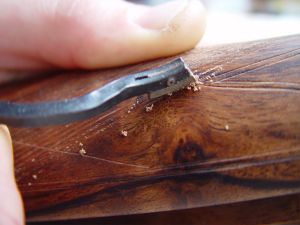
| Checkering in progress
On the left is a picture of checkering being applied to a stock. The master lines are cut first and then duplicated with parallel lines. One of the two masterlines is still visible in the lower corner on the left of the picture.
Once the lines have been laid out the grooves will be deepened with a cutter.
The checkering tool used is a modern tool. A so called spacer to lay out the lines. In this case a Gunline tool.
|
Some antique English checkering tools
On the right are three antique tools used for checkering.
The uppermost (wood with pin) is a sort of scriber, that was used to mark the edges of the checkering so they run parallel with the barrel channel (top line) of the stock.
Below there is a very fine checkering tool (English flattop).
The lower tool (steel) is a special tool for cutting borders (mullered borders).
| 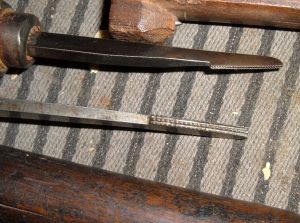
|

| Fish scale checkering
Anoher type of checkering is fish scale checkering. It is a completely different technique. Actually, it is more of a carving technique since special gauges are used.
I have never seen this technique being used in Britain or America.
However, in the German speaking countries it is quite popular.
The technique is very time consuming and during cutting one most be very concentrated to prevent the scales from breaking out.
Fish scales provide very good grip to the shooters hand and can be used to emphasize the beauty of the stock. However, it takes some getting used to at first.
|
|

